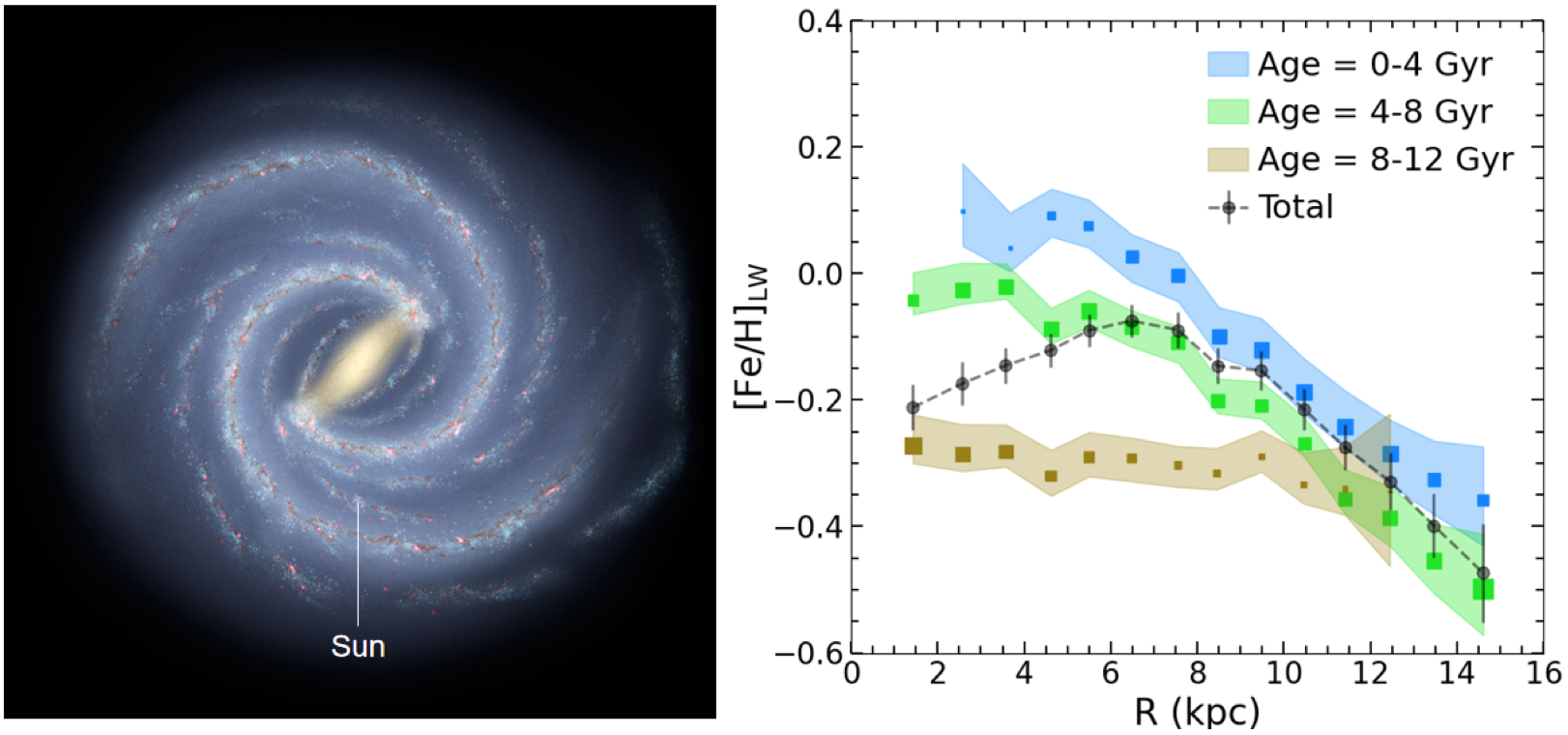中国西南天文研究所研究团队揭示银河系恒星平均金属元素丰度的分布
The integrated metallicity profile of the Milky Way
地面和太空望远镜的观测向我们展示了银河系以外其他星系(即河外星系)丰富多变的形态和光谱。理解我们的银河系,探究其与其他星系相比会不会是一个特殊的星系等具有重要科学意义。近年来天文学的快速发展,特别是对银河系和河外星系观测上的进步,为这些问题答案提供了前所未有的机遇。在最新一项由德国马克斯•普朗克天文研究所和中国云南大学西南天文研究所研究人员领导的工作中,利用APOGEE恒星光谱巡天数据,研究人员从星系恒星化学组成的角度描绘了从外部视角观察我们银河系将会看到的“模样”,从而为银河系和河外星系之间进行直接比较打开了窗口。
星系是由大量恒星组成的,而恒星主要化学成分是氢和氦,但也有一些比氦更重的元素,这些元素在天文学中被约定俗成地统称为“金属元素”。恒星内部金属元素的多少一定程度反映了它们的诞生时间。金属元素越多的恒星通常诞生在更晚的时期。研究星系化学组成一个关键的问题是:星系不同区域的恒星金属元素含量是怎样随着与星系中心的距离(即半径)的变化而变化的。然而由于我们处于银河系内,对银河系的观测是很不均匀的,同时银河系内的气体和尘埃也会严重影响我们的观测,所谓不识庐山真面目,只缘身在此山中,这是银河系研究的重大挑战。在这项工作中,为研究银河系金属元素的分布,研究人员对观测的不均匀性、尘埃和恒星的特性进行综合分析,从而正确的重建了银河系中恒星的真实分布。
研究结果表明从银河系中心向外,恒星的平均金属含量先逐步增加,在距中心约23000光年处达到接近我们太阳的金属含量(我们的太阳距离银河系中心约26000光年)。而在更远的距离上,平均金属含量再次下降,在距中心约50000光年处下降到大约太阳值的三分之一。研究人员进一步分析了其他星系的相关特征,发现在我们的真实宇宙以及模拟宇宙中分别只有1%和11%的星系表现出了这种特性,大部分星系的金属含量都是从内向外单调递减的。这表明,就金属含量的分布而言,我们的银河系是不寻常的,但并不是独一无二的。基于对模拟星系的初步分析,银河系金属含量从内向外先增加的一个可能原因是银河系中心超大质量黑洞喷发,从内向外地抑制了近期的恒星形成,使得更中心的区域年老的贫金属恒星更多。
该项研究为我们了解银河系提供了一个全新的外部视角,引发了众多需要深入研究的重要科学问题。下一代的银河系巡天将能帮助我们更为全面地描绘银河系,从而深入理解其形成与演化。
该项研究工作已发表在《自然天文学》(Nature Astronomy)杂志上,题目为《银河系的整体金属丰度分布》(The integrated metallicity profile of the Milky Way),文章链接:https://rdcu.be/dfiTf。新利18体育新的连建辉副教授是文章第一作者和通讯作者,参与该研究的合作者Maria Bergemann(马普天文所),Annalisa Pillepich(马普天文所),Gail Zasowski(犹他大学)和Richard R. Lane(贝尔纳多•奥希金斯大学)。

图1. 左图:银河系河外视角想象图。右图:银河系恒星平均金属含量随半径的变化。
Figure 1. Left panel: Imaginary picture of the Milky Way looking from outside. Right panel: The variation of average stellar metallicity of the Milky Way.

Observations from ground-based and space telescopes showed us the diverse shape and spectra of extragalactic systems, or galaxies beyond our Milky Way. Understanding our own Milky Way and how it compares to other galaxies has important scientific implications. Recent rapid developments in astronomy, particularly in observations of the Milky Way and extragalactic systems, have provided us unprecedented opportunities to answer these questions. In a recent study led by researchers from the Max Planck Institute for Astronomy in Germany and South-Western Institute for Astronomy Research at Yunnan University in China, researchers described the "appearance" of our Milky Way as seen from outside in terms of stellar chemical composition using data from the APOGEE stellar spectroscopic survey. This study paves the way for direct comparison between the Milky Way and extragalactic systems.
Galaxies are composed of a large number of stars, whose main chemical components are hydrogen and helium, but there are also heavier elements than helium, which are conventionally referred to as "metal elements" in astronomy. The amount of metal elements inside stars to some extent reflects their birth time. Stars with more metal elements typically form later. A key question in studying the chemical composition of galaxies is how the metallicity of stars in different regions of the galaxy changes with distance from the galaxy center (i.e., radius). However, due to our position inside the Milky Way, observations of the Milky Way are highly uneven, and gas and dust within the Milky Way also severely affect our observations. This poses a significant challenge in studying the Milky Way. In this study, to investigate the distribution of metal elements in the Milky Way, researchers conducted a comprehensive analysis of the unevenness of observations, dust, and stellar properties, thereby correctly reconstructing the true distribution of stars in the Milky Way.
The results show that the average metal content of stars gradually increases from the center of the Milky Way outward and reaches a maximum abundance of metal content close to that of our Sun at a distance of about 23,000 light-years from the center (for reference, our Sun is about 26,000 light-years away from the center of the Milky Way). At further distances, the average metal content decreases again and drops to about one-third of the solar value at a distance of about 50,000 light-years from the center. The researchers further analyzed the relevant characteristics of other galaxies and found that only 1% and 11% of galaxies in our real universe and simulated universe, respectively, exhibit this feature. Most galaxies have metallicity that monotonically decreases from the inside out. This suggests that as far as the distribution of metallicity is concerned, our Milky Way is unusual but not unique. Based on preliminary analysis of simulated galaxies, one possible reason why the metal content of the Milky Way first increases with radius is due to the feedback powered by a supermassive black hole at the center of the Milky Way, which suppresses recent star formation from the inside out, resulting in more old, metal-poor stars in the central region.
This research provides an intriguing external perspective for us to understand the Milky Way and raises many important scientific questions that require further investigation. The next generation of Milky Way surveys will help us more comprehensively depict the Milky Way and thus deepen our understanding of its formation and evolution.
The study has been published in the journal Nature Astronomy, entitled "The integrated metallicity profile of the Milky Way." Jianhui Lian, an associate professor at South-Western Institute for Astronomy Research at Yunnan University, is the leading and corresponding author of the article. Co-authors of the study include Maria Bergemann (Max Planck Institute for Astronomy), Annalisa Pillepich (Max Planck Institute for Astronomy), Gail Zasowski (University of Utah), and Richard R. Lane (Bernardo O'Higgins University).
